
Gulab jamun is a sweet confectionary or dessert, originating in the Indian subcontinent, and a type of mithai popular in India, Pakistan, Nepal, the Maldives and Bangladesh, as well as Myanmar. It is also common in nations with substantial populations of people with South Asian heritage, such as Mauritius, Fiji, Gulf states, the Malay Peninsula, United Kingdom, United States, Canada, South Africa, and the Caribbean countries of Jamaica, Trinidad and Tobago, Guyana, and Suriname.
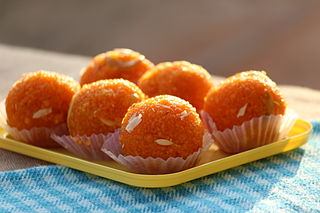
Laddu or laddoo is a spherical sweet from the Indian subcontinent made of various ingredients and sugar syrup or jaggery. It has been described as "perhaps the most universal and ancient of Indian sweets."
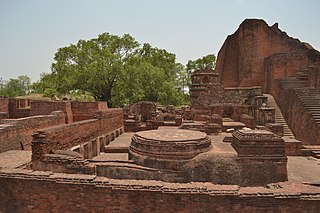
Nalanda district is one of the thirty-eight districts of the state of Bihar in India. Bihar Sharif is the administrative headquarters of this district. The districts is home to the ancient Nalanda Mahavihara a UNESCO World Heritage Site. Nalanda is located in the Magadh region of southern Bihar.
Mithai (sweets) are the confectionery and desserts of the Indian subcontinent. Thousands of dedicated shops in India, Bangladesh, Nepal, Pakistan and Sri Lanka sell nothing but sweets.

Indian breads are a wide variety of flatbreads and crêpes which are an integral part of Indian cuisine. Their variation reflects the diversity of Indian culture and food habits.
Bhojpuri cuisine is a style of food preparation common among the Bhojpuri people of Bihar, Jharkhand and eastern Uttar Pradesh in India, and also the Terai region of Nepal. Bhojpuri foods are mostly mild and tend to be less hot in terms of spices used. The cuisine consists of both vegetable and meat dishes.
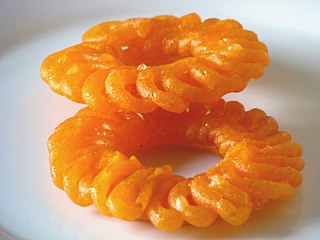
Imarti is a sweet from India. It is made by deep-frying vigna mungo flour batter in a circular flower shape, then soaking in sugar syrup. Alternative names include Amitti, Amriti, Emarti, Omritti, Jahangir and Jhangiri/Jaangiri. This dish is not to be confused with jalebi, which is thinner and sweeter than Imarti.

Malpua, or sometimes shortened to pua, is a sweetened breakfast served with morning tea or as a snack with afternoon tea or as a dessert originating from the East Indian subcontinent, popular in Bangladesh, Bhutan, India, Nepal, and Pakistan.
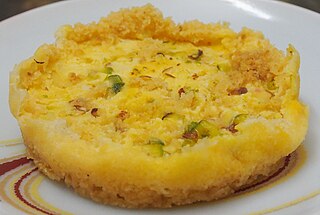
Ghevar or Ghewar is a disc-shaped Rajasthani sweet with a honeycomb-like texture, made from ghee, maida, and sugar syrup. It is traditionally associated with the month of Shraavana and the festivals of Teej and Raksha Bandhan. It is a part of Rajasthani tradition and is gifted to newly married daughter on Sinjara, the day preceding Gangaur and Teej. It is also one of the Chhapan Bhog served to the Lord Krishna. Besides Rajasthan, it is also famous in the adjoining states of Haryana, Delhi, Gujarat, Uttar Pradesh, and Madhya Pradesh.

Ariselu or Arisa is an Indian sweet from Andhra Pradesh, Odisha, Telangana. It is also called Kajjaya in Kannada, Adhirasam in Tamil Nadu, Neyyappam in Kerala ,Anarsa in Marathi, arsa or anarsa in Uttarakhand, Bihar and Jharkhand.

Kakinada Kaja is a traditional sweet pastry from Kakinada in Andhra Pradesh, India, known for its unique taste and preparation. It comes in two main varieties: the hollow, cylindrical Gottam Kaja and the layered Madatha Kaja, each offering distinct textures and flavours. The dessert holds significant cultural importance in Andhra Pradesh, with efforts underway to obtain a Geographical Indication (GI) tag to preserve its legacy. Along with the related Tapeswaram Kaja, it remains a beloved delicacy throughout the Telugu states.

Gujhia, also known as Gughara, Pedakiya, Purukiya, Karanji, Kajjikayalu, Somas, and Karjikayi, is a sweet, deep-fried pastry that is a popular dessert in the Indian subcontinent. This delicacy is made using either suji (semolina) or maida, which is stuffed with a mixture of sweetened khoa and dried fruits. The dumpling is then fried in ghee to give it a crispy texture.

Sweet shells is one of the typical Indian sweets made in Andhra Pradesh, India. It is a mixture (dough) of plain flour/maida and water or milk. The prepared dough is shaped into small rounds, which are flattened and rolled so as to take the shape of gavvalu. These shells are fried in oil or ghee and soaked in sugar or jaggery syrup.
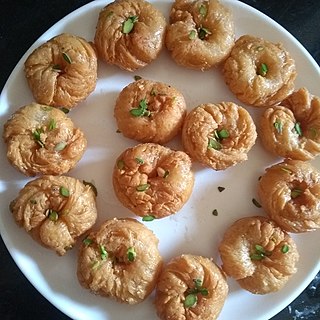
Makhan Bada is a traditional dessert originating from the Indian subcontinent. It is also known as Balusaahi and is similar to a glazed doughnut in terms of Ingredients, but differs in texture and taste. Makhan Bada also resembles Rajasthani Baati in terms of size & preparation but resembles more with Medu Vada in terms of shape. In South India, a similar pastry is known as badusha.
Bihari cuisine is eaten mainly in the eastern Indian state of Bihar, as well as in the places where people originating from the state of Bihar have settled: Jharkhand, Eastern Uttar Pradesh, Bangladesh, Nepal, Mauritius, South Africa, Fiji, some cities of Pakistan, Guyana, Trinidad and Tobago, Suriname, Jamaica, and the Caribbean. Bihari cuisine includes Angika cuisine, Bhojpuri cuisine, Maithil cuisine and Magahi cuisine. Dal Puri
Tapeswaram is a village in Mandapeta mandal of Konaseema district, Andhra Pradesh. The Uma Agastheswara Temple in Tapeswaram has a great importance and is believed to be constructed by Agasthya.

Andhra cuisine, culturally known as Telugu cuisine, is a cuisine of India native to the state of Andhra Pradesh and is the culinary style of Telugu people. It is generally known for its tangy, hot, and spicy taste.
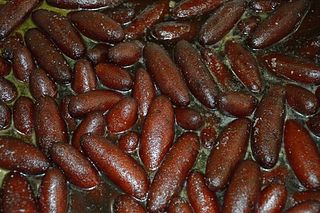
Lyangcha, Langcha, or Lemcha, is an Indian sweet dish prepared in West Bengal, Jharkhand, Odisha, Bihar, Assam, Tripura and also throughout Bangladesh. It is made from flour and milk powder by frying it and dipping it into sugar syrup for a long time. The origin of the sweet is in Bardhaman, West Bengal, India. The Government of West Bengal has begun the process of registering Geographical indication (GI) for Lyangcha.

Maithil cuisine, also known as Mithila cuisine, is a part of Indian and Nepalese cuisine. It is the traditional cooking style of Maithils residing in the Mithila region of the subcontinent.

Gulgula is a traditional sweet made in different regions of India. It is one of the most popular sweets in the market places, it is traditionally made on specific festive occasions in rural areas. They are common in Uttar Pradesh, Bihar, Punjab, Odisha, Haryana, Rajasthan and are also made by overseas Indians in Guyana, Trinidad and Tobago, Suriname, Jamaica, Mauritius, the United States, South Africa, and Fiji.
















